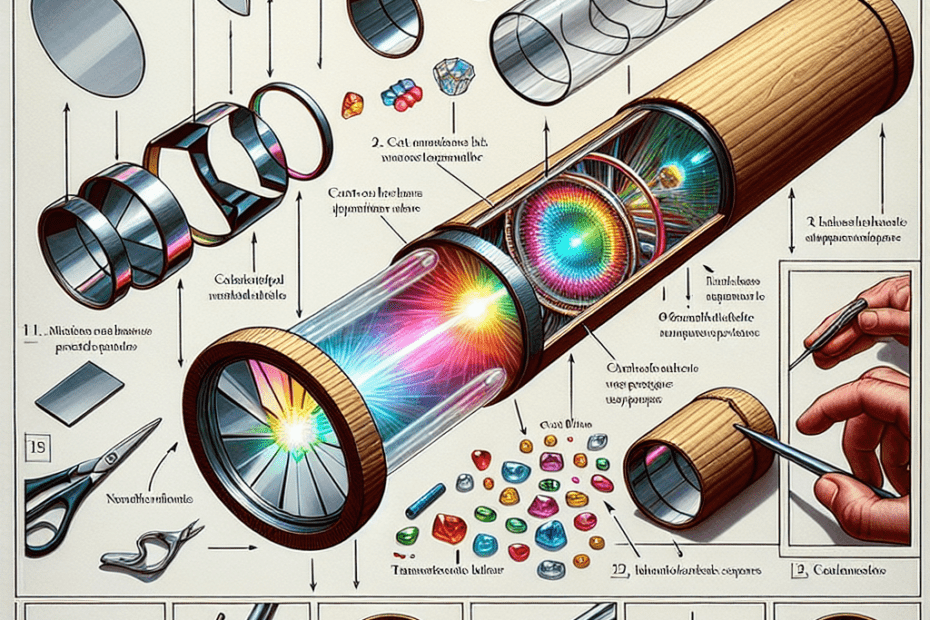Discover the Magic: DIY Kaleidoscope
Ever wondered how those beautiful, colorful patterns are created inside a kaleidoscope? Building your own DIY kaleidoscope can be both a fun and educational experience. It’s a fantastic way to blend science with art, unleashing a world of creativity and discovery.
What is a Kaleidoscope?
A kaleidoscope is a cylindrical tube with mirrors inside that reflects light and colorful objects, creating symmetrical patterns as you rotate it. Invented in 1816 by Sir David Brewster, kaleidoscopes have enchanted people of all ages for generations.
Materials Needed
| Material | Description |
|---|---|
| Cardboard tube | A sturdy tube, like from a paper towel roll |
| Mirrors or reflective sheets | Three rectangular pieces, self-adhesive reflective plastic or compact CD pieces can work |
| Transparent color beads or shapes | Create the patterns inside the kaleidoscope |
| Plastic disc | To seal the end of the tube, preferably a clear plastic |
| Adhesive tape and glue | To hold pieces together |
| Decorative paper | To cover the outside of your tube |
Step-by-Step Guide
- Prepare the Mirrors: Cut your mirrors or reflective sheets into three equal rectangles. The size should fit inside your cardboard tube.
- Make the Mirror Triangle: Use tape to join these reflective pieces at edges, forming a triangular prism. Ensure reflective sides face inward.
- Insert the Mirror Tube: Carefully slide this triangle into your cardboard tube.
- Add the Color Beads: Place your colorful beads or shapes at one end of the tube, ensuring they are visible through the opening.
- Seal with the Plastic Disc: Use a clear plastic disc to cover the end containing the beads, securing it with glue or tape.
- Decorate Your Kaleidoscope: Cover the outside of your tube with decorative paper to personalize your creation.
- Enjoy the View: Once it’s dry, look through the open end and rotate the tube to enjoy the ever-changing patterns.
Science Behind the Kaleidoscope
The kaleidoscope operates on the principles of light reflection. When light enters the kaleidoscope, it reflects off the mirrors at angles, producing repetitive patterns. This simple play of light and reflection creates complex designs that are similar to fractals, which are patterns that recur at progressively smaller scales.
Statistics and Fun Facts
Did you know? According to a study published in the Journal of Experimental Child Psychology, engaging in activities like crafting kaleidoscopes helps improve children’s spatial skills by up to 30% (source: Journal of Experimental Child Psychology, 2021). Additionally, a survey conducted by STEM Learning found that 82% of kids showed increased interest in science and arts after participating in hands-on projects.
Key Takeaways
- A DIY kaleidoscope is a fun and educational project, combining elements of art and science.
- Essential materials include a cardboard tube, mirrors, colorful beads, and a plastic disc.
- The construction involves creating a mirror triangle and decorating your tube for a personalized touch.
- The kaleidoscope’s magic lies in its ability to reflect light and create symmetrical patterns.
FAQ Section
- What age group is suitable for making a DIY kaleidoscope?
- This activity is generally suitable for children aged 8 and up, with supervision for younger kids.
- Can I use mirrors from old CDs?
- Yes, CD fragments can be used as an alternative to mirror strips, but handle them carefully to avoid cuts.
- What can replace the plastic disc in the kaleidoscope?
- If a plastic disc is unavailable, you can use any transparent plastic sheet, such as a piece from a report cover.
- How does a kaleidoscope enhance learning?
- DIY kaleidoscopes foster creativity and improve spatial and geometrical understanding through hands-on learning.
- What are some design tips for my kaleidoscope?
- Use vibrant colors and patterns for decoration to make your kaleidoscope as visually appealing as possible.
